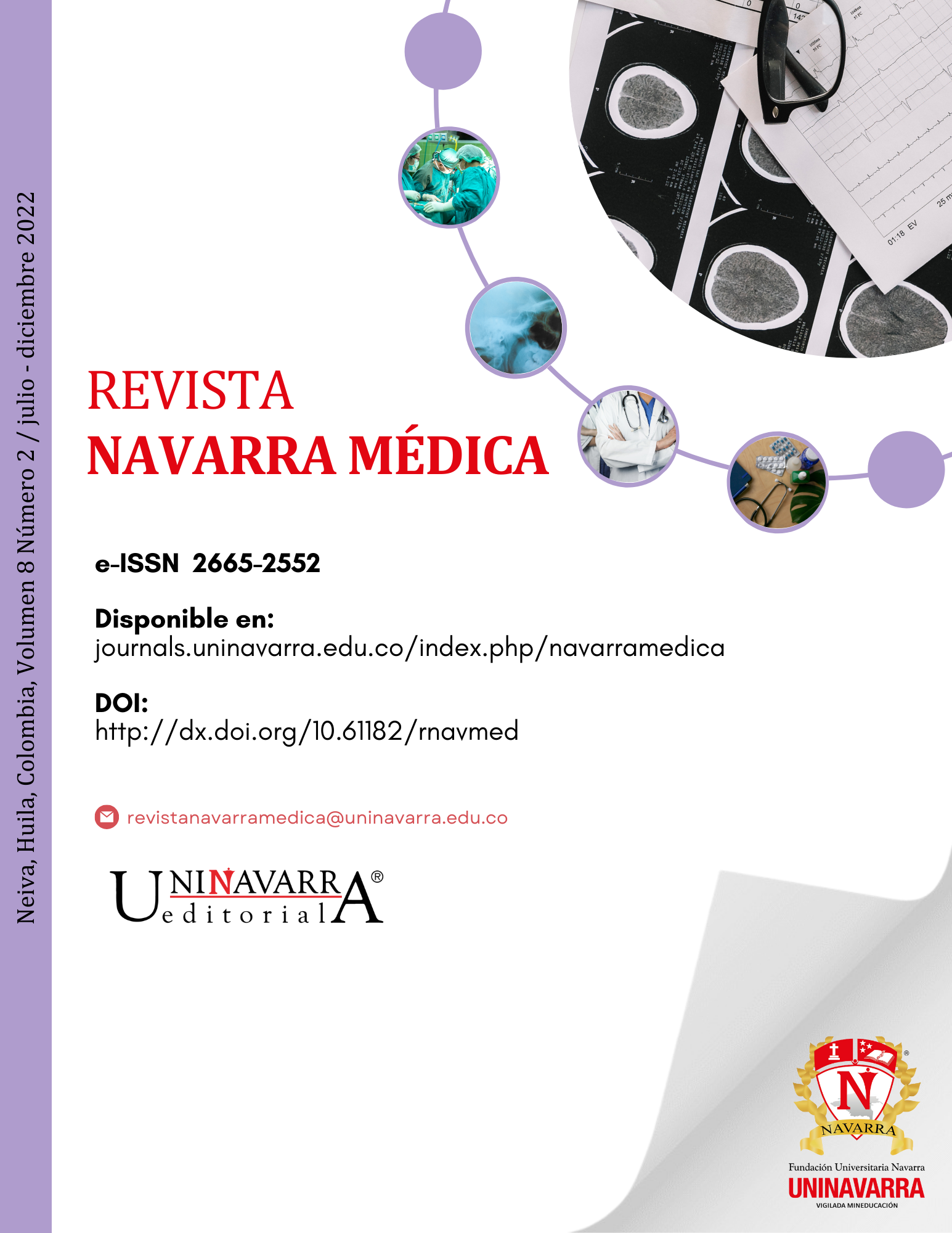Shock index as a predictor of mortality in trauma patients during the first 72 hours
DOI:
https://doi.org/10.61182/rnavmed.v8n2a2Keywords:
Shock Index , Trauma , MortalityAbstract
Introduction: Trauma is a public health problem that affects millions of people every year, generating a high rate of disability and mortality in young patients, for this reason the use of prognostic tools such as the shock index (IS) would allow attention timely and effective emergency services by identifying tissue hypoperfusion parameters and clinical outcomes.
Methods: A descriptive, cross-sectional observational study was carried out in polytraumatized patients who were admitted from January 2019 to December 2019 in a University hospital in Colombia. The variables were evaluated, and the result was determined according to the shock index, generating a dichotomous variable with two groups: group A, with an index less than 0,9, and group B, with one greater than 0.9; a univariate analysis was done. Measures of central tendency and dispersion were calculated for continuous variables.
Results: 180 patients were analyzed, 56,6 % (102) is less than 0,9 and 43,3 % (78), greater than 0.9. The average age for group A was 38,7 years and, for group B, 30,2 years. Mortality at 72 hours was 16,6 % in group A and 80,7 % in group B. for a total of 44,4 %. Survival at 72 hours for group A was 83,3 % and for B 19,2 %, out of a total of 55,5 %.
Conclusion: SI facilitates the choice of treatments according to the state of severity, since a score greater than 0.9 is associated with mortality; aspect that would prioritize emergency care by medical personnel, in patients who are apparently stable, but according to the IS have a poor prognosis. The results suggest that this index may be useful in predicting adverse outcomes and in defining fluid resuscitation.
References
1. World Health Organization. Los traumatismos: el problema sanitario desatendido en los países en desarrollo [Internet]. WHO [citado 26 de marzo de 2020]. Disponible en: https://www.who.int/bulletin/volumes/87/4/08-052290/es/
2. World Health Organization. Las 10 principales causas de defunción [Internet]. WHO [citado 26 de marzo de 2020]. Disponible en: https://www.who.int/es/news-room/fact-sheets/detail/the-top-10-causes-of-death
3. World Health Organization. Global status report on road safety 2018 [Internet]. WHO. [citado 22 de septiembre de 2020]. Disponible en: http://www.who.int/violence_injury_prevention/road_safety_status/2018/en/
4. Gruen RL, Brohi K, Schreiber M, Balogh ZJ, Pitt V, Narayan M, et al. Haemorrhage control in severely injured patients. Lancet. 2012;380(9847):1099-108. doi: 10.1016/S0140-6736(12)61224-0
5. Charry JD, Bermeo JM, Montoya KF, Calle-Toro JS, Núñez LR, Poveda G. Índice de shock como factor predictor de mortalidad en el paciente con trauma penetrante de tórax. Rev Colomb Cir. 2015;30(1):24-28. doi:10.30944/20117582.307
6. Yücel N, Lefering R, Maegele M, Vorweg M, Tjardes T, Ruchholtz S, et al. Trauma Associated Severe Hemorrhage (TASH)-Score: probability of mass transfusion as surrogate for life threatening hemorrhage after multiple trauma. J Trauma. 2006;60(6):1228-36; discussion 1236-7. doi:10.1097/01.ta.0000220386.84012.bf
7. McLaughlin DF, Niles SE, Salinas J, Perkins JG, Cox ED, Wade CE, et al. A predictive model for massive transfusion in combat casualty patients. J Trauma. 2008;64(2 Suppl):S57-63; discussion S63. doi: 10.1097/TA.0b013e318160a566
8. Vandromme MJ, Griffin RL, Kerby JD, McGwin G Jr, Rue LW 3rd, Weinberg JA. Identifying risk for massive transfusion in the relatively normotensive patient: utility of the prehospital shock index. J Trauma. 2011;70(2):384-8; discussion 388-90. doi:10.1097/TA.0b013e3182095a0a
9. Diaztagle Fernández JJ, Gómez Núñez WA, Plazas Vargas M. Utilización del índice de shock en el manejo de pacientes con sepsis severa y choque séptico: una revisión sistemática. Acta Colomb Cuid Intensivo. 2016;16(4):262-9. doi:10.1016/j.acci.2016.08.005
10. Campos-Serra A, Montmany-Vioque S, Rebasa-Cladera P, Llaquet-Bayo H, Gràcia-Roman R, Colom-Gordillo A, et al. The Use of the Shock Index as a Predictor of Active Bleeding in Trauma Patients. Cir Esp (Engl Ed.). 2018;96(8):494-500. doi: 10.1016/j.cireng.2018.09.007
11. Rady MY, Smithline HA, Blake H, Nowak R, Rivers E. A comparison of the shock index and conventional vital signs to identify acute, critical illness in the emergency department. Ann Emerg Med. 1994;24(4):685-90. doi:10.1016/s0196-0644(94)70279-9
12. Kortbeek JB, Al Turki SA, Ali J, Antoine JA, Bouillon B, Brasel K, et al. Advanced trauma life support, 8th edition, the evidence for change. J Trauma. 2008;64(6):1638-50. doi:10.1097/TA.0b013e3181744b03
13. Lee CWC, Kory PD, Arntfield RT. Development of a fluid resuscitation protocol using inferior vena cava and lung ultrasound. J Crit Care. 2016;31(1):96-100. doi: 10.1016/j.jcrc.2015.09.016
14. Colciencias. Política de ética, bioética e integridad científica [Internet]. Bogotá: Colciencias; 2017. Disponible en: www.colciencias.gov.co/sites/default/files/upload/noticias/politica-etica.pdf
15. Cannon CM, Braxton CC, Kling-Smith M, Mahnken JD, Carlton E, Moncure M. Utility of the shock index in predicting mortality in traumatically injured patients. J Trauma. 2009;67(6):1426-30. doi:10.1097/TA.0b013e3181bbf728
16. Montoya KF, Charry JD, Calle-Toro JS, Núñez LR, Poveda G. Shock index as a mortality predictor in patients with acute polytrauma. J Acute Dis. 2015;4(3):202-4.doi:10.1016/j.joad.2015.04.006
17. Terceros-Almanza LJ, García-Fuentes C, Bermejo-Aznárez S, Prieto-del Portillo IJ, Mudarra-Reche C, Sáez-de la Fuente I, et al. Predicción de hemorragia masiva. Índice de shock e índice de shock modificado. Med Intensiva. 2017;41(9):532-8. doi:10.1016/j.medin.2016.10.016
18. McNab A, Burns B, Bhullar I, Chesire D, Kerwin A. A prehospital shock index for trauma correlates with measures of hospital resource use and mortality. Surgery. 2012;152(3):473-6. doi:10.1016/j.surg.2012.07.010
19. Al Jalbout N, Balhara KS, Hamade B, Hsieh Y-H, Kelen GD, Bayram JD. Shock index as a predictor of hospital admission and inpatient mortality in a US national database of emergency departments. Emerg Med J. 2019;36(5):293-7. doi:10.1136/emermed-2018-208002
20. Strutt J, Flood A, Kharbanda AB. Shock Index as a Predictor of Morbidity and Mortality in Pediatric Trauma Patients. Pediatr Emerg Care. 2019;35(2):132-7. doi:10.1097/PEC.0000000000001733
21. Jehan F, Con J, McIntyre M, Khan M, Azim A, Prabhakaran K, et al. Pre-hospital shock index correlates with transfusion, resource utilization and mortality; The role of patient first vitals. Am J Surg. 2019;218(6):1169-74. doi:10.1016/j.amjsurg.2019.08.028
22. Nordin A, Shi J, Wheeler K, Xiang H, Kenney B. Age-adjusted shock index: From injury to arrival. J Pediatr Surg. 2019;54(5):984-8. doi:10.1016/j.jpedsurg.2019.01.049
23. Chung J-Y, Hsu C-C, Chen J-H, Chen W-L, Lin H-J, Guo H-R, et al. Shock index predicted mortality in geriatric patients with influenza in the emergency department. Am J Emerg Med. 2019;37(3):391-4. doi:10.1016/j.ajem.2018.05.059
24. El Ayadi AM, Nathan HL, Seed PT, Butrick EA, Hezelgrave NL, Shennan AH, et al. Vital sign prediction of adverse maternal outcomes in women with hypovolemic shock: the role of shock index. PLoS ONE. 2016;11(2):e0148729. doi:10.1371/journal.pone.0148729
Downloads
Published
Issue
Section
License
Copyright (c) 2025 Sergio A. Cristancho-Losada , Sammy Felipe Castellanos-Rojas

This work is licensed under a Creative Commons Attribution-NonCommercial 4.0 International License.








